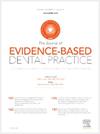利多卡因联合可乐定用于2型糖尿病患者上颌浸润麻醉的有效性和安全性:双盲、随机临床试验
IF 4
4区 医学
Q1 DENTISTRY, ORAL SURGERY & MEDICINE
引用次数: 0
摘要
目的:本临床试验旨在评价和比较2%利多卡因与可乐定(15mcg/ml)或肾上腺素(1:10万)上颌浸润麻醉后伴有和不伴有2型糖尿病(DMT2)患者的口腔软组织麻醉参数、心血管功能和局部副作用发生率。方法将63例DMT2患者和52例非糖尿病患者随机分为两组,分别给予2 mL利多卡因加可乐定(LC)和2 mL利多卡因加肾上腺素(LE)进行上颌浸润麻醉。针刺试验评价软组织麻醉的起效、持续时间、麻醉场宽度等参数。在麻醉前和麻醉后30分钟用监护仪监测收缩压(SBP)、舒张压(DBP)和心率(HR)。术后7天内,分别用氯乙烯喷雾剂和单丝组进行定量感觉测试,检测术后有无痛觉过敏和感觉异常。记录拔牙后24小时的抢救性镇痛请求。结果DMT2组上颌浸润麻醉的起始时间明显短于H组(P <;0.05),无论使用何种局麻溶液。DMT2-LE组麻醉时间比H-LE组长59% (P <;0.05), DMT2-LC组比H-LC组延长28% (P <;. 05)。DMT2-LE组上颌浸润麻醉持续时间比DMT2-LC组长37.9%(182.09±57.86 min vs 139.48±21.86 min) (P <;. 05)。与非糖尿病患者相比,糖尿病患者麻醉视野宽度显著增加(P <;0.05),以及DMT2-LE与DMT2-LC(35.19±1.67mm vs. 27.07±1.06 mm) (P <;. 05)。与基线值相比,DM-LC组和H-LC组在第15 ~ 30分钟的收缩压显著降低。与基线值相比,在接受LE治疗的糖尿病和非糖尿病患者中,从第5分钟到第30分钟,HR显著增加。术后感觉异常在DMT2-LE组明显多于DMT2-LC组(P <;0.05),而在非糖尿病患者中未观察到。结论DMT2患者上颌浸润麻醉起效时间较短,持续时间较长。在麻醉效果、心血管安全性和局部副作用发生率方面,可乐定似乎是DMT2患者口服麻醉中肾上腺素的安全替代品。本文章由计算机程序翻译,如有差异,请以英文原文为准。
EFFICACY AND SAFETY OF LIDOCAINE WITH CLONIDINE FOR MAXILLARY INFILTRATION ANESTHESIA IN PATIENTS WITH DIABETES MELLITUS TYPE 2: DOUBLE-BLIND, RANDOMIZED CLINICAL TRIAL
Objectives
This clinical trial aimed to evaluate and compare parameters of intraoral soft tissue anesthesia and cardiovascular function, and prevalence of local side effects in patients with and without diabetes mellitus type 2 (DMT2), after maxillary infiltration anesthesia obtained with 2% lidocaine with either clonidine (15mcg/ml) or epinephrine (1:100.000).
Methods
Sixty-three DMT2 and 52 nondiabetic (H) patients scheduled for tooth extraction were randomly assigned to receive one of the local anesthetic solutions for maxillary infiltration anesthesia: 2 mL of lidocaine with clonidine (LC) or 2 mL of lidocaine with epinephrine (LE). Parameters of soft tissue anesthesia (onset, duration and width of anesthetic field) were evaluated by pinprick test. Systolic blood pressure (SBP), diastolic blood pressure (DBP) and heart rate (HR) were monitored with patient monitor, before and until 30 minutes after anesthesia application. Presence of postoperative hyperalgesia and paresthesia during 7 postoperative days was tested with ethylene-chloride spray and monofilaments set for quantitative sensory testing, respectively. Requests for rescue analgesic were recorded for 24 hours after tooth extraction.
Results
Onset of maxillary infiltration anesthesia was significantly shorter in DMT2 vs. H groups (P < .05), regardless of local anesthetic solution used. Duration of anesthesia was 59% longer in DMT2-LE vs. H-LE (P < .05), and 28% longer in DMT2-LC vs. H-LC groups (P < .05). Maxillary infiltration anesthesia lasted 37,9% longer in DMT2-LE vs. DMT2-LC (182.09 ± 57.86 min vs. 139.48 ± 21.86 min) (P < .05). Width of anesthetic field was significantly increased in diabetic vs. nondiabetic participants (P < .05), as well as in DMT2-LE vs. DMT2-LC (35.19 ± 1.67mm vs. 27.07 ± 1.06 mm) (P < .05). SBP was significantly decreased within DM-LC and H-LC groups from 15th to 30th minute, in comparison with baseline values. Significant increase in HR was observed from 5th to 30th minute in diabetic and nondiabetic patients who received LE, compared to baseline values. Postoperative paresthesia was significantly more present in DMT2-LE vs. DMT2-LC (P < .05), while it was not observed in nondiabetic patients.
Conclusions
Shorter onset and prolonged duration of maxillary infiltration anesthesia are present in DMT2 setting. Clonidine appears to be a safe alternative to epinephrine for intraoral anesthesia in DMT2, with respect to anesthetic efficacy, cardiovascular safety and prevalence of local side effects.
求助全文
通过发布文献求助,成功后即可免费获取论文全文。
去求助
来源期刊

Journal of Evidence-Based Dental Practice
DENTISTRY, ORAL SURGERY & MEDICINE-
CiteScore
6.00
自引率
16.70%
发文量
105
审稿时长
28 days
期刊介绍:
The Journal of Evidence-Based Dental Practice presents timely original articles, as well as reviews of articles on the results and outcomes of clinical procedures and treatment. The Journal advocates the use or rejection of a procedure based on solid, clinical evidence found in literature. The Journal''s dynamic operating principles are explicitness in process and objectives, publication of the highest-quality reviews and original articles, and an emphasis on objectivity.
 求助内容:
求助内容: 应助结果提醒方式:
应助结果提醒方式:


